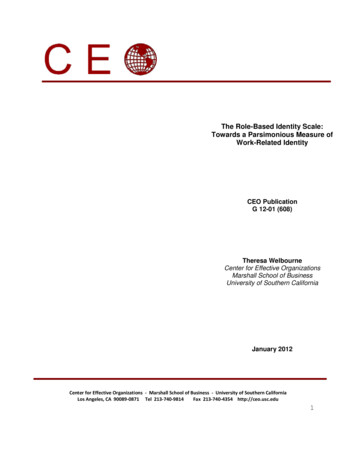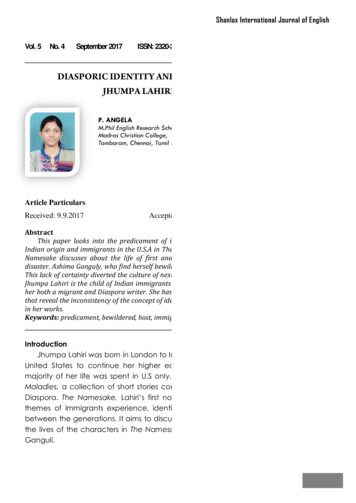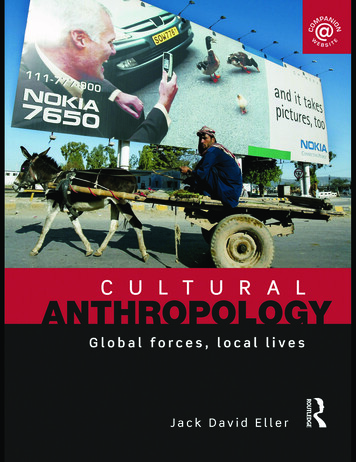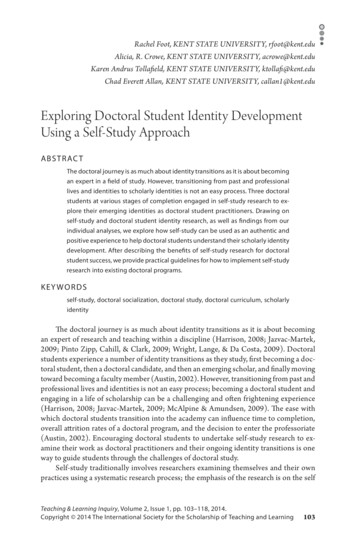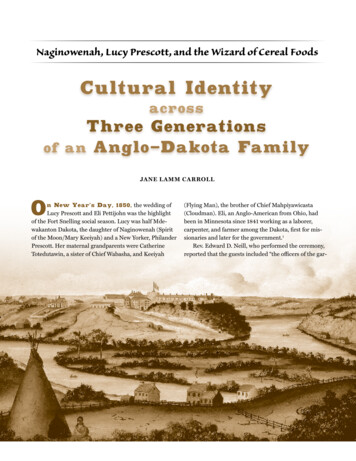
Transcription
Naginowenah, Lucy Prescott, and the Wizard of Cereal FoodsCultural IdentityacrossThree Generationsof an Anglo-Dakota FamilyJane Lamm CarrollOn New Year’s Day, 1850, the wedding ofLucy Prescott and Eli Pettijohn was the highlightof the Fort Snelling social season. Lucy was half Mdewakanton Dakota, the daughter of Naginowenah (Spiritof the Moon/Mary Keeiyah) and a New Yorker, PhilanderPrescott. Her maternal grandparents were CatherineTotedutawin, a sister of Chief Wabasha, and Keeiyah(Flying Man), the brother of Chief Mahpiyawicasta(Cloudman). Eli, an Anglo-American from Ohio, hadbeen in Minnesota since 1841 working as a laborer,carpenter, and farmer among the Dakota, first for missionaries and later for the government.1Rev. Edward D. Neill, who performed the ceremony,reported that the guests included “the officers of the gar-
rison in full uniform, with their wives, the United StatesAgent for the Dahkotahs, and family, the bois brules ofthe neighborhood, the Indian relatives of the mother. Themother did not make her appearance,” Neill said, but, asthe ceremony began, “the Dahkotah relatives, wrapped intheir blankets, gathered in the hall and looked in throughthe door.” A family friend recalled that no one couldpersuade Naginowenah to be in the parlor during theceremony, although “immediately afterwards she waitedon the wedding guests.” 2The orientation of the guests at this Presbyterianceremony presented a symbolic tableau of the culturaltransition that was taking place from one generation tothe next in Lucy Prescott’s family. Her Dakota relativesviewed the wedding from the hallway, not as full guestsor participants but as interested observers—and also as apeople whose culture Lucy was leaving farther behind asshe married an Anglo-American.Naginowenah’s refusal to attend the ceremony isintriguing. Presumably she, too, watched through theparlor door. Perhaps, like her Dakota kin, she felt morelike an interested but somewhat detached observer thana full participant in her daughter’s wedding. PerhapsNaginowenah harbored mixed feelings about Lucy’smarriage, although she herself was married to an AngloAmerican and had long been a member of the FirstPresbyterian Church. Theoretically, then, she should havebeen happy to see Lucy married to a devout Christian,but maybe she also mourned the loss of the Dakota wayof life for her daughter.Despite Naginowenah’s 40-year marriage to Philander Prescott, church membership, and immersion inEuro-American society at Fort Snelling, she spoke onlythe Dakota language, although she perfectly understoodboth French and English. Thus, Naginowenah’s acculturation, while significant in some ways, was limited. Herlife straddled both Indian and Euro-American cultures,but her identity was as a Dakota woman. For most of thefirst three decades of her marriage, she lived in a societythat was dominated by Dakota and Euro-Dakota people.3Lucy’s Dakota identity, in comparison, was greatlydiminished. After living her early childhood as a Dakotagirl, she was brought up mainly to be an Anglo-AmericanTime, place, and coming changes: The confluence of the Min nesota and Mississippi rivers, Mendota ( foreground), andFort Snelling, about 1850, the year Lucy Prescott marriedEli Petti john. Painting by Sgt. Edward K. Thomas, who waswoman. She spoke Dakota but was also fluent andliterate in English. She would raise her children asAnglo-Americans. By the time Lucy married in 1850,Minnesota’s population was on the verge of a seismicshift. American and European immigrants poured intothe region after the treaties of the early 1850s, whichforced the Dakota onto the Minnesota River reservations and opened the west side of the Mississippi Riverto settlement. Lucy Prescott Pettijohn would spend heradulthood in a society dominated by non-Indians.Years later, William A. Pettijohn, one of Lucy’s sonsand Naginowenah’s grandsons, became a successfulbreakfast-food manufacturer in California.In 1890, at the ageof 36, he returned toMinneapolis at theinvitation of severalbusinessmen who wereeager to partner withhim. Within threeyears, these men hadswindled him, and hewas forced to sell hiscompany at a great loss. In 1900 William staged a comeback, announcing his return to the industry in a bold,colorful brochure. Claiming both his pioneer and Dakotaheritages, William exhorted the reader to “Be a GoodIndian” and to “Eat Pettijohn’s Indian Brand Products.”His company’s slogans were “The Pioneer of ’Em All” and“Under the Indian Brand.” Anointing Pettijohn the “Wizard of Cereal Foods,” the brochure presented his historyas a prominent manufacturer whose breakfast foods hadbecome a household name.4The story of the Keeiyah-Prescott-Pettijohn familyspans three generations and links the history of preterritorial Minnesota to the late-nineteenth-centuryhistory of milling and manufacturing in Minneapolis,two eras that historians usually treat as distinct chaptersin the region’s past. In particular, the development ofMinneapolis in the later nineteenth century too often hasbeen presented as if it were unrelated to the area’s population before the U.S.–Dakota War of 1862. In fact, someBy the time Lucymarried in 1850,Minnesota’spopulation wason the verge of aseismic shift.Dr. Carroll, a professor of history at St. Catherine University,St. Paul, has published numerous articles in this magazine.Her essay on the McLeod family in early Minnesota won Minnesota History’s award for best article in 2007.stationed at the fort.Summer 2012 59
why Naginowenah agreed to marry Philander Prescottbecause she did not leave her own account of her life.What we do know from his account is that he was interested in her for three years before he actually courted her,and then it took some time before she was persuaded tomarry him.In 1820 Prescott came to the fort to work as a clerkin the sutler’s store, where he first met Naginowenah.He recalled in his memoir:During the last summer that I was at the sutler’s store[1821] the young woman that I had seen on my wayup the Mississippi, a daughter of one of the chiefs,came into the store frequently to trade quill work ofmockasins [sic] and many other little articles. . . . Herappearance and conduct attracted my attention and,in fact, the young woman got acquainted with all theofficers’ ladies at the fort and she became very muchrespected.7William A. Pettijohn, the Wizard of Cereal Foods,from his company’s brochureDakota and Euro-Dakota people, including many womenmarried to Euro-American men, stayed in the Minneapolis area during and after the war. Others began to returnfrom exile as early as the mid-1860s, either reestablishingthemselves in Dakota and Euro-Dakota communities orintegrating into Euro-American society. Naginowenah,Lucy, and many of their children remained in Minnesota,most of them ultimately living in Minneapolis, Shakopee,and Excelsior. 5Although attracted to Naginowenah, Prescott wascourting another Dakota woman and so did not pursueher. Not long after, however, he decided that he wantedto marry Naginowenah but kept quiet, knowing that hehad to leave for St. Louis for the winter. In June 1822,Prescott returned to Minnesota and set up a trading postnear Fort Snelling. There Naginowenah called occasionally to trade. During the winter of 1823–24, Prescottresolved to ask her to be his wife.I began to think about getting married after the Indianmanner, so I took ten blankets, one gun, and five gallonsof whiskey and a horse and went to the old chief ’s lodge.I laid them down and told the old people my errand andwent home. The third day I received word that my giftNaginowenah was born in 1802 on theshores of Lake Calhoun. The acculturation ofthe Keeiyah-Prescott-Pettijohn families began in the1820s, when the establishment of Fort Snelling broughtincreasing numbers of non-Indians into the region. Ashistorians have shown, native women frequently enteredinto unions with Euro-American traders and, later, withsoldiers and government officials because they saw suchrelationships as socially and economically beneficial tothemselves and their kin. The material benefits thesemarriages brought to both spouses, of course, did notpreclude other influences such as mutual admiration,love, and sexual attraction.6 We cannot know for certain60 Minnesota Histor yhad been accepted, but that the girl was bashful and didnot like the idea of marrying, and I must wait until theycould get the girl reconciled to their wishes for her tomarry me.In a few days they moved their tent up and campednear my house, and it was ten [days] before I couldget my wife, as she was then timid. At last, throughmuch entreaty of the parents, she came for to be mywife or companion as long as I chose to live with her.Little did I think at the time that I should live with heruntil old age.8Naginowenah was 21 years old and Philander was 32.They would be married for 40 years and have nine chil-
The development of Minneapolis in the later nineteenth centurytoo often has been presented as if it were unrelated to the area’spopulation before the U.S.–Dakota War of 1862.dren, five of whom would live to adulthood. In the earlyyears of their marriage they were often apart, as Prescottleft to trade at various locations or to travel downriverfor supplies. Their first child, William, was born in 1824.When William was only three years old, Prescott foundhimself unemployed and decided to move to St. Louis tolive with his brother and find work. He left Naginowenahand William behind with no money for their support, ashe was deeply in debt. He asked the sutler’s clerk to extend credit to his wife until he returned.9Naginowenah and William lived near Fort Snellingduring Prescott’s absence. It was there that Lucy wasborn in 1828. When Prescott returned to Minnesota for avisit that year, Naginowenah informed him that she wasno longer willing to live apart. She said she would ratherbe poor—she was tired of living alone, and the other traders were annoying her, saying Prescott would never comeback. Undoubtedly she was worried that, like so manyother Dakota women who married traders, she might beabandoned. Prescott went back to St. Louis to settle hisbusiness affairs and returned to live with his family inMinnesota.10In the spring of 1829, U.S. Indian Agent LawrenceTaliaferro hired Prescott as a farmer for the Lake Calhoun Dakota, and Naginowenah and their two childrenmoved with him back to her birthplace. There her father,Keeiyah, had brought his band to join with his brotherCloudman and his band in an experiment to see if theycould sustain themselves through agriculture and reduce their dependence on hunting. As the number ofnon-Indians in the region increased, it became moreand more difficult for the Mdewakanton, the easternmost Dakota, to find adequate amounts of wild game.They were forced to go farther and farther west to huntbuffalo and other large animals, necessitating long andarduous journeys that took them away from their villagesfor months at a time. Cloudman had asked Taliaferro tosupply the bands with plows and horses so they couldplant larger quantities of corn and other crops than theamount traditionally cultivated.11New Hope (St. Peter’s) Cantonment, 1820, temporary quarterswhile Fort Snelling was being built. Graphite drawing byAda B. Morrill.
This shift to greater reliance on agriculture also entailed a change in traditional Dakota gender roles, as itbecame necessary for the men to assist the women incultivating and harvesting. Within a few years, the community was harvesting large amounts of corn, as well assquash, pumpkins, potatoes, and cabbages. As the village became more successful, it attracted more people,including many Dakota women and their children whohad been abandoned by Euro-American husbands andfathers.Cultural conflicts marked the early yearsof Naginowenah’s and Prescott’s marriage andfamily life. Relations were especially strained over thenature of William’s upbringing. Prescott clashed on morethan one occasion with his mother-in-law, CatherineTotedutawin, whose influence over William, often indefiance of his wishes, infuriated him. William becamethe center of a dispute over cultural identity: would hebe raised as primarily a Dakota or an Anglo boy? In thefall of 1832, when William was eight years old, Prescottlearned of the Choctaw Academy, a free governmentboarding school in Kentucky for Indian and Euro-Indianchildren. He sent William down the Mississippi River ina canoe with the Indian subagent and two French-Dakotaboys who were also to attend. To Prescott’s dismay, William’s grandmother followed the party downriver, foundtheir encampment, and insisted on bringing the boy backhome.12When Prescott scolded his mother-in-law for interfering, Naginowenah became so angry that she left withtheir children for several weeks, only returning becausetheir third child, three-year-old Harriet, was severely ill.This created another cultural conflict between husbandand wife. Naginowenah refused to move back into theirlog house, staying instead in her parents’ lodge. She andher relatives attempted to heal the girl with Dakota medicine and refused to listen to Prescott’s treatment advice.After a few weeks, Harriet died. While Prescott was angrythat Naginowenah and his in-laws had not heeded him,he did not blame them for her death, acknowledging thatthey had done what they thought best for the child. Still,Harriet’s death and the family conflict over her treatmentmade Prescott more determined than ever to send William to school, away from Dakota influence.I said to myself that my son should not be raisedamongst the Indians, for the old woman had perfectcontrol of him when she was about. She thought moreof him than of any of her own children . . . and wasmaking a perfect Indian of him. . . . I was determinedto send him off the first opportunity that offered, forthe old woman had made me repent the day that Ihad ever taken her daughter.In the fall of 1834, Prescott enrolled William at the Choctaw Academy.During these years, Naginowenah and Prescott movedback and forth between Mendota, Fort Snelling, andTraverse des Sioux, as Prescott worked for various employers in the fur trade. Late in 1835, the couple suffereda severe blow when they learned that William had died atthe Choctaw Academy, apparently as a result of neglectand abuse. The entire family was devastated, none moreso than Prescott, who had insisted on sending the boy. Oftheir other children, only Lucy—as a teenager—would besent away to school.13Samuel Pond’s map of his environs, including Lake Calhounand the Dakota village, enclosed in a January 1835 letter home.Pond drew on an irregularly shaped scrap of paper, about 4¾inches high, and noted the map’s shortcomings on the back. Thisversion appeared in his Two Volunteer Missionaries Among theDakota (1893).
Although he does not speak of it in his recollections, Prescott was so distraught by William’s death thathe seems to have suffered an emotional breakdown.He abandoned Naginowenah and their two survivingchildren, Lucy and Hiram, and traveled down the Mississippi River, wandering through Louisiana, Texas, andthe southeastern United States, drinking heavily alongthe way. In his absence, Naginowenah gave birth to theirthird daughter, Caroline, in 1836. At some point in histravels, Prescott encountered a preacher, found God, andrepented for having abandoned his family. He returnedto Minnesota in the winter or spring of 1837 and trackedNaginowenah and the children to the Upper MissouriRiver, where the Calhoun bands had gone to hunt buffalo. There he sought Naginowenah’s forgiveness, askingher to come back with him and marry him in the Christian church and under American law. She consented.Sadly, not long after their reunion, in April 1837, Caroline died.14Prescott and Naginowenah decided to associatethemselves with the Presbyterian mission at Lake Harriet, established two years earlier by Samuel and GideonPond and Rev. J. D. Stevens. There, Prescott built a smalllog house. The family joined the mission church in June1837, and Naginowenah was baptized and took the nameTHEPrescott FamilyNaginowenah and Philander Prescott hadnine children in the first two decades oftheir 40-year marriage. Five of the childrensurvived to adulthood. William, 1824–35 Lucy, 1828 Harriet, 1829–33 Hiram, 1832 Caroline, 1836–37 Lawrence Taliaferro, 1838 Julia, 1841 Sophia, 1844 Mary Elizabeth, 1846–48Mary. Then, 14 years after their Dakota marriage, Naginowenah and Prescott were married by Samuel Pond.The wedding service was said partly in English and partlyin Dakota, and both Naginowenah’s demeanor and attirereflected the inherent tensions of her situation as a newlyChristianized Dakota marrying an Anglo-Americanman, surrounded by Presbyterian missionaries andwhite congregants. Described by a female missionary asappearing uncomfortable, Naginowenahwore a wedding outfitthat combined Dakotaand European garb:“moccasins, bluebroadcloth pantaletsand skirt with a finecalico print shortgown, ornamentedwith 5 bright patchesof tan, three or fourinches in diameteron the waist in front.Several dozen strings of dark cut glass beads hung uponher neck and her ears were loaded with ear drops. A bluebroadcloth blanket thrown over her shoulders completedher wedding dress.” 15The Lake Harriet mission and Lake Calhoun farming village lasted only a few more years. Although thevillage successfully sustained a large population (about500 inhabitants in its last year), an attack in 1839 by theDakotas’ traditional enemy, the Ojibwe, caused fear andintroduced an era of renewed warfare. After the harvestof 1839, the Calhoun Dakota scattered to establish newvillages to the south along the Minnesota River, wherethey would be closer to the other Mdewakanton bands aswell as to Fort Snelling. In the spring of 1840, the Pondsfollowed Cloudman’s band to Oak Grove (now Bloomington), where they established a new mission.16In the years between 1840 and 1843, Naginowenahand the children lived with her Dakota kin at Oak Grovewhile Prescott struggled, mostly unsuccessfully, to support his growing family as a farmer and trader. Then, in1843, their financial well-being was ensured for a whilewhen Prescott secured the position of government interpreter to the Dakota, which brought a regular salaryand housing at Fort Snelling. The family lived in a stonehouse next to the Indian agent’s dwelling, just outside thefort’s walls, for about ten years. By this time, Naginowenah and Prescott had had two more children: LawrenceCultural conflictsmarked theearly years ofNaginowenah’sand Prescott’smarriage andfamily life.Summer 2012 63
upper Minnesota River. The family continued to live nearMinnehaha Falls while Prescott traveled between thehomestead and the reservation. During this period, heand his son-in-law Eli Pettijohn partnered with anotherman to build a flour mill on the creek at what is nowFifty-Third Street and Lyndale Avenue. The mill becamethe nucleus of a trading center that quickly developedinto Richfield Township.20At some point in the late 1850s, perhaps after Hirammarried in 1857, Naginowenah and the three remaining children moved to live with Prescott on the LowerSioux Agency. When the U.S.–Dakota War broke out in1862, Prescott was one of the first people killed. Althoughwarned by Dakota friends to stay indoors, he apparentlypanicked and tried to flee to Fort Ridgely. A group ofDakota warriors, including chiefs Little Six and MedicineBottle, encountered Prescott on the road and killed him.Lucy later said she had heard that the two chiefs hadargued about killing her father; one of them said thatPrescott had “always been a friend to the Indians.” 21Philander PrescottTaliaferro (born 1838) and Julia (born 1841). Soon, theyadded Sophia (1844) and Mary Elizabeth (1846) to thefamily.17 It was during this time that Lucy and Eli Pettijohn married.John H. Stevens, a close friend who lived with thePrescotts for several years, described Naginowenah as“an excellent housekeeper, fond of her domestic duties,an affectionate wife and good mother.” She was known forher hospitality to strangers, and she operated their homeas an informal inn, as there was no such accommodationin the area. Indeed, in Naginowenah’s 1867 obituary, theMinneapolis Chronicle remembered her for “having keptan open house at Fort Snelling” for many years.18In 1854 Prescott lost his job, and the family left thestone house at Fort Snelling. Naginowenah, now 52, andPrescott, 63, established a homestead about a half milefrom Minnehaha Falls. They had four children still livingwith them: Hiram, age 22, Lawrence Taliaferro, 16, Julia,13, and Sophia, 10. Their house sat on the main routefrom Fort Snelling to St. Anthony Falls, at what is nowForty-Third Street and Minnehaha Avenue in south Minneapolis. The family operated it as a tavern and inn formany years.19Not long out of work, Prescott was hired in 1854 to besupervisory farmer (and later, government interpreter)for the newly established Dakota reservations on the64 Minnesota Histor yLittle Six and Medicine Bottle, photographedat Fort Snelling, 1864
When the U.S.–Dakota War broke out in 1862,Prescott was one of the first people killed.Convinced that she and her children would be protected by their Dakota kin, Naginowenah stayed onthe reservation. Along with many other Dakota andEuro-Dakota people, the family was taken as captivesto Little Crow’s camp. During the Battle of Wood Lake,Naginowenah and Julia escaped with a number of otherprisoners to Fort Ridgely.22Naginowenah and all of her children survived thewar. In the years afterward she lived with Lucy, Eli,and their children in Shakopee. In 1867, aged 65, shedied there—just 12 miles from her birthplace at LakeCalhoun. Her obituary describes her as “noble . . . industrious, frugal, and kind.” In addition, “She was a goodwife, a fond mother, and one of the most even-temperedand consistent women we ever knew. She relieved thewants of the poor, visited the sick, and bestowed deedsof charity upon those who were needy. She was neveridle.” 23 William Pettijohn, the future Wizard of CerealFoods, was 13 years old when his Dakota-speakinggrandmother died in his home.J. D. Stevens had outlined strict rules for deportment,study, and work, one visitor who resided at the missionfor several months described a school in which the students ruled.The principle upon which the boarding school at thisplace appears to be conducted is somewhat singular. . . .[L]et every child and scholar have as much liberty andindulgence as he would have. . . . I am, and have been,ever since I came here, so much disturbed by these boarding girls, that I could scarcely do anything in the way ofreading or writing after they retired to bed. For they seldom spent less than an hour or two in chatting, laughing,squealing, etc. I never knew of a horde of children gratified with so many indulgences as these here are.25Lucy Prescott, born near Fort Snellingin 1828, lived her young childhood completely as a Dakota girl, surrounded by her mother’skin. Her father was absent for several years afterher older brother’s death, returning to his familyin 1837, when Lucy was nine. When her parentsjoined the Lake Harriet mission church that year,Lucy’s first significant exposure to Anglo-Americanculture began: She and her brother Hiram werebaptized. Then, during the winter and springof 1837–38, Lucy attended the mission’s boarding school for Anglo-Dakota girls. Studentswere taught to read and write in Dakota butalso learned “manners,” “morals,” housekeeping,and sewing.24 At the school with Lucy were hermother’s cousins’ children, including the daughterof Indian agent Taliaferro. Although missionaryJ. D. Stevens’s “Regulations of the Mission School atLake Harriet, 1836,” sent to Henry H. SibleySummer 2012 65
Lucy was 15 in 1843 when her family moved into thehouse at Fort Snelling. In the years between the LakeHarriet mission and the fort, she and her siblings hadsporadically attended the Ponds’ mission school at OakGrove. Then, sometime between 1843 and 1849, Prescottarranged for Lucy to attend an eastern boarding schoolfor several years.26 There, she would have been immersedcompletely in Anglo-American society and received aneducation solely in English and the subjects thoughtsuitable for genteel young women. Within a few years ofher return from school, at the age of 22, she married EliPettijohn, who by then had been in the region for aboutnine years. In contrast to her parents’ Christian wedding,Lucy’s ceremony and attire were strictly Anglo-American.Only the presence of her mother and Dakota relativeswas evidence that the bride was Anglo-Dakota.Lucy and Eli would have seven children—four boysand three girls—between 1850 and 1873. William, thefuture cereal man, was their third child (and second son),born in 1854.27Between 1857 and 1862, Lucy and Eli lived on theirown farm near Fort Snelling, where they operated aboardinghouse and supplied food and lumber to the fort.But the U.S. government did not recognize Eli’s claim tothe land and, in 1862, forced them to leave their home.The family moved to Shakopee, living there until the1890s when they relocated to Minneapolis. For the rest ofhis life, Eli Pettijohn unsuccessfully sought compensationfrom the government for his lost land and house.28In the 1870s Eli moved to California for a time, tak-THEPettijohn FamilyLucy and Eli Pettijohn had seven childrenin a marriage that lasted almost 60 years.All survived into adulthood. Philander Prescott, 1850 Anna, 1852 William A., 1854 Lawrence, 1858 Samuel R., 1860 Minnie, 1863 Harriet Julia Prescott, 1871ing several of his adult sons with him. There he foundeda successful cereal brand, Pettijohn’s, which his son William took over after Eli returned to Minnesota. In 1900,fifty years after their marriage, Lucy and Eli were livingin their house near Minnehaha Creek. Lucy died there in1910 (at age 81), five miles from her birthplace near FortSnelling. Eli died at a son’s home in Minnetonka Mills(now Excelsior) in 1915, aged 96.29The cover of the 1900 Pettijohn Pure Prod-ucts brochure features an Indian man dressed ina loincloth and eagle-feather headdress, as if he is aboutto go into battle. He kneels as he pounds grain upon astone. The scene grossly misrepresents traditional nativegender roles while also expressing white stereotypes thatidentified Indian men as either warriors or children. Thedepiction effectively emasculates the man by casting himin a traditional female role even while dressed as a warrior. The slogan “Be a Good Indian” is both patronizingand racist in its assumptions that native people should betreated as children and that they are bad unless qualifiedas good.On the other hand, the company’s advertising couldbe interpreted more positively: It does not deny Petti john’s Indian heritage but, rather, celebrates it. Oneof the products bears a Dakota name, Wamana-Haci(Indian Mixture), and the company logo is an illustrationof a warrior, although inaccurate. Heralding William’sreturn to cereal manufacturing, the brochure concludeswith a cultural reclamation, albeit a dubious one, of hisfamily’s Dakota heritage: “Pettijohn’s back! The wholecountry will know it and welcome the news. The goodIndian is marking a trail to your grocer’s door.” 30William Pettijohn, the “good Indian,” was one-quarterDakota and spent five of the formative years of his childhood (ages 8 to 13) in a household with his Dakotagrandmother, Naginowenah. His company’s brochureraises interesting questions that cannot be answered,based on the documentary record: Did William privatelynurture his Dakota heritage? Should his advertising beread merely as a crass commercial exploitation of whitestereotypes about Indians or as homage to his Dakotaancestry? Did he accept white stereotypes about hisgrandmother’s people? Was he cognizant or unaware ofthe advertisement’s cultural distortions?One wonders what William’s mother, Lucy PrescottPettijohn, thought of the company’s use of her Dakotaheritage. Did the Indian warrior pounding grain strike
One wonders whatWilliam’s mother,Lucy PrescottPettijohn, thoughtof the company’suse of her Dakotaheritage.her as ridiculous, humiliating, or both?Did she laugh or did she wince? Was sheresigned to the fact that her son was sofully acculturated into Euro-Americansociety that he shared its inaccurate andstereotypical notions of their Dakotaancestors? Had she actively encouraged the adoption of his Euro-Americanviews? Or was it more likely that shethought it unwise to curtail his acculturation in the face of an overwhelming,dominant Euro-American populationthat was generally hostile to Indians,especially after the 1862 war when somewhites publicly called for the genocideof all Indians in Minnesota? As an Anglo-Dakota womanwho had become almost completely assimilated intoAnglo-American society herself, did Lucy Prescott Pettijohn, perhaps, share some of the stereotypes and negativeviews about Indians?Like Lucy, Naginowenah’s other surviving childrenwere raised to live as Anglo-Americans and to integrateinto the dominant society. Julia, Sophia, and Hiram allmarried Anglo-Americans. The one exception was heryoungest son, Lawrence Taliaferro Prescott, who marriedMarion Robertson, an Anglo-Dakota woman whose family lived on the Lower Sioux Reservation.31In the next generation, all of Lucy and Eli’s childrenwho married (Anna and Samuel did not) chose AngloAmerican spouses. They appear to have had little or noidentity as Dakota, except perhaps for retaining a smattering of the language and some inherited artifacts.32The lives of Naginowenah, her daughterLucy Prescott, and her grandson William Petti john provide a fascinating window into the processFront and back of the red, white, blue (and yellow)company brochure, 1900of acculturation that occurred among Dakota and AngloDakota people over several gener
first three decades of her marriage, she lived in a society that was dominated by Dakota and Euro-Dakota people.3 Lucy's Dakota identity, in comparison, was greatly diminished. After living her early childhood as a Dakota girl, she was brought up mainly to be an Anglo-American woman. She spoke Dakota but was also fluent and literate in English.


